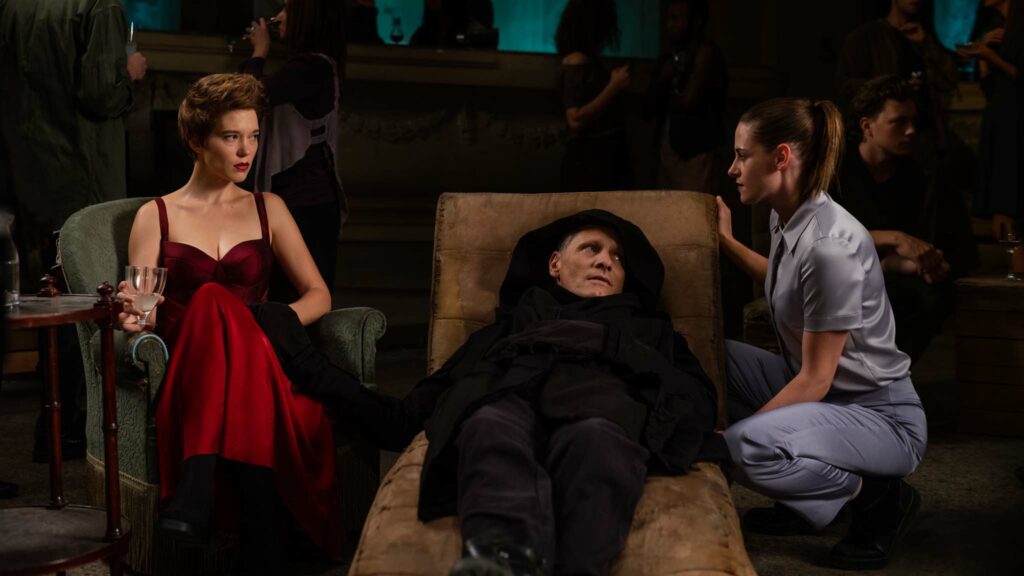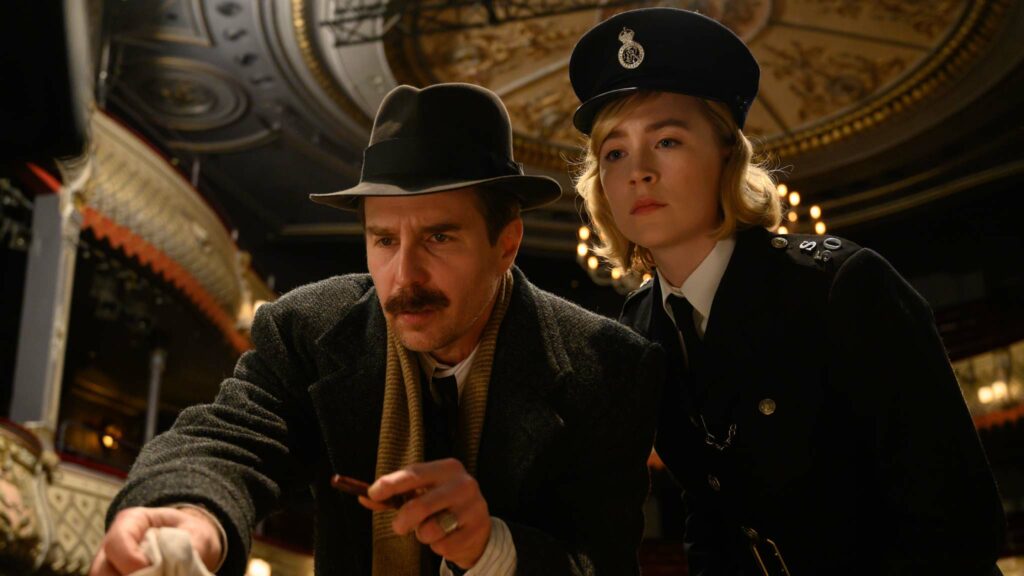Horror
Bodies Bodies Bodies (15)
Review: Death frequently becomes the depraved and the deserving in slasher films. Teenage fornicators are doomed to a grim demise along with drug takers, unwanted intruders, abusers, bullies and miscreants responsible for the beleaguered hero’s deep physical and psychological wounds. A resourceful babysitter in peril or the sole survivor of an unprovoked attack are clearly telegraphed as protagonists to root for. Vengeance is theirs, bathed in lashings of blood and gore as they turn the tables on merciless aggressors (until the inevitable sequel).
In director Halina Reijn’s twisted satire Bodies Bodies Bodies, none of the characters are particularly likeable or sympathetic. These hedonistic twentysomething brats would be easy fodder for slaughter in another horror film so when a children’s game in the dark spirals wildly out of control with tragic consequences, screenwriter Sarah DeLappe provides no clear instructions about who we should trust. Her script brilliantly captures the vapidness of a self-absorbed generation, which lives and dies by social media and its own relentless self-promotion.
Characters are insufferable and deluded – rich pickings for a gifted ensemble cast led by Rachel Sennott and Amandla Stenberg, who ratchet up the hysteria with lip-smacking aplomb. The gnarly resolution of a central whodunnit is less satisfying, relying on coincidence and some questionable logic to deliver a final narrative gut-punch.
Sophie (Stenberg) and her new girlfriend Bee (Maria Bakalova) travel along winding hillside roads to a hurricane party at a remote mansion hosted by Sophie’s best buddy David (Pete Davidson) and her coterie of rich friends. “They’re gonna be obsessed with you,” Sophie assures Bee, who is being granted entry to this privileged inner circle for the first time. Shortly before the downpour of rain begins, Bee is introduced to David and his girlfriend Emma (Chase Sui Wonders), Jordan (Myha’la Herrold), Alice (Sennott) and her older boyfriend Greg (Lee Pace) – another first-time addition to the group.
Their response to Bee isn’t particularly warm or welcoming. As alcohol and drugs flow, and Bee unknowingly devours a cannabis-spiked chocolate cake, the group elects to play a game of Bodies Bodies Bodies during a storm-related power outage. Tension between revellers explodes in the darkened house and one member of the hedonistic party plays a murder victim for real. Paranoia and suspicion run amok as hallucinating survivors grab a meat cleaver from the kitchen to hunt a real-life killer in their ranks.
Bodies Bodies Bodies gleefully pokes fun at Gen Z stereotypes as the body count steadily rises and on-screen allegiances fray. Director Reijn uses glow sticks and mobile phone torches as roaming sources of light during the power cut to focus our attention and heighten discomfort. It’s a slow, steady build of suspense – there are no traditional jump scares – in the company of cheerfully masked monsters.
.
Find Bodies Bodies Bodies in the cinemas
Thriller
Crimes Of The Future (18)
Review: How do you solve a problem like microplastics – tiny particles created for commercial use or broken down from discarded single-use items in the environment – and mitigate their impact on delicate marine ecosystems? Cinematic provocateur David Cronenberg’s audacious solution is a queasy, futuristic nightmare in which evolved humans consume the plastic they manufacture and discard, chomping hungrily on the rim of a wastepaper bin or snacking on beach detritus including water bottles. Save the planet we have relentlessly pillaged and poisoned by exploiting a dominant species’ gluttony and greed.
Crimes Of The Future harks back to the Canadian writer-director’s glorious past and his popularisation of the body horror genre with stomach-churning features including Shivers, Rabid, Videodrome and The Fly. Here, surgery is “the new sex” and self-mutilation is elevated to an orgiastic artform: a rush of blood to the head and loins that renders obsolete old-fashioned expressions of intimacy. “I’m sorry. I’m not very good at the old sex,” apologises Viggo Mortensen’s performance artist after a lacklustre physical kiss with Kristen Stewart’s smitten admirer.
Arousal is reserved for an operating table where fully conscious, nude characters quietly moan and whimper as scalpel-wielding robotic arms controlled by human hands slice through their gently heaving skin and extract extraneous organs. These clinical extractions in front of enraptured camera-wielding audiences are one of many blackly humorous titillations in Cronenberg’s curiously erotic and languorous picture.
In an unspecified bleak future of pronounced decay and pollution, developments in human evolution have largely eradicated physical pain. A government department called the National Organ Registry (NOR) is responsible for cataloguing new organs that donors such as world-renowned performance artist Saul Tenser (Mortensen) grow within their own bodies. Saul’s partner Caprice (Lea Seydoux) surgically removes these unwanted growths as the centrepieces of their well-attended artistic endeavours.
NOR officer Wippet (Don McKellar) and his sexually repressed colleague Timlin (Stewart) take a special interest in the couple’s activities. Timlin fixates on Saul and he entertains her advances, appraising his new admirer as “rather attractive… in a bureaucratic way”. Their fates collide with underground revolutionary Lang Dotrice (Scott Speedman), who hopes the artists will perform a live autopsy on his eight-year-old son Brecken (Sozos Sotiris) to publicly challenge prevailing wisdom on the human condition.
Crimes Of The Future is a clinical, precise and achingly stylish thriller that revisits key themes from the filmmaker’s oeuvre. Eye-catching production design conflates the grotesque and gory with post-apocalyptic glamour, notably in the strangely skeletal technology that Saul requires to eat and sleep comfortably. Stewart delivers an appealingly creepy portrayal of pent-up sexual tension, invading Mortensen’s personal space by excitedly forcing her fingers into his mouth during one uncomfortably charged exchange. She is the most wonderful facet of Cronenberg’s artfully composed weirdness.
Find Crimes Of The Future in the cinemas
Comedy
See How They Run (12A)
Review: During a pithy opening voiceover, a witness to a diabolical crime in London’s glittering West End takes us into their confidence and playfully dismisses the tangled web that screenwriter Mark Chappell is about to spin for our entertainment: “It’s a whodunnit. You’ve seen one, you’ve seen ’em all.” This is a rare instance when a character in director Tom George’s comical 1950s-set murder mystery is telling the truth. Chappell’s script openly and affectionately borrows from Agatha Christie, introducing a motley crew of duplicitous suspects, who will try (and fail) to pull the wool over the bloodshot eyes of a detective with their own personal demons.
Knowing winks and smirks are peppered throughout See How They Run, a reference to the nursery rhyme Three Blind Mice and the title of Christie’s 1950 short story which inspired the longest running play in the world, The Mousetrap. This is the kind of self-referential, effervescent romp in which a snooty playwright on screen decries flashbacks as “the last refuge of a moribund imagination” directly before a mosaic of recollections to neatly distil the plot. Sam Rockwell retains a firm grasp on a gruff British accent as the hangdog lead detective, contrasting delightfully with Saoirse Ronan’s eager-to-please rookie constable, who always jumps to conclusions and snags some of the best one-liners.
In spring 1953 at the Ambassadors Theatre, cast and crew of The Mousetrap are abuzz with excitement about an impending film version of Agatha Christie’s smash hit play. Producer John Woolf (Reece Shearsmith) has secured the movie rights through stage impresario Petula Spencer (Ruth Wilson) – with Christie’s blessing – and obnoxious American director Leo Kopernick (Adrien Brody) will call the shots on an adaptation penned by pernickety playwright Mervyn Cocker-Norris (David Oyelowo).
A post-show soiree to celebrate the production’s 100th performance degenerates into crustacean-encrusted fisticuffs and a lifeless body is discovered on stage. Metropolitan Police Inspector Stoppard (Rockwell) and Constable Stalker (Ronan) arrive at the theatre to crack the case. Everyone is a suspect including the play’s stars Richard Attenborough (Harris Dickinson) and wife Sheila Sim (Pearl Chanda), Mervyn’s taxidermist “nephew” Gio (Jacob Fortune-Lloyd), Woolf’s devoted assistant Ann Saville (Pippa Bennett-Warner) and theatre usher Dennis (Charlie Cooper). “I’ll never get the hand of this in time for sergeant’s exams,” despairs Stalker.
See How They Run is a frightfully jolly jape that simultaneously venerates and pokes fun at the musty conventions of a murder mystery. Chappell’s script skilfully conflates facts about The Mousetrap and fanciful fiction without ruining the play’s closely guarded secret. The identity of the murderer in George’s immaculately designed picture won’t incite gasps of surprise but there is unabashed fun in the film’s stylish execution and some terrific performances. Nothing is certain but death and Shirley Henderson hungrily scene-stealing the denouement.
Find See How They Run in the cinemas
Animation
Tad The Lost Explorer And The Curse Of The Mummy (U)
Review: A decade after construction worker turned treasure seeker Tad Stones began his award-winning computer-animated escapades, the accident-prone hero faces creatures from the Egyptian underworld in a third big screen mission helmed by Spanish director Enrique Gato. A 10-year anniversary gift is traditionally made of tin or aluminium. Alas, some of the humour in Tad The Lost Explorer And The Curse Of The Mummy sinks like a lead balloon, particularly one freewheeling joke about a yellow jersey Tour de France cyclist who is denied his rightful place in sporting history by a runaway bathtub. The Mona Lisa also suffers an ignominious fate on the walls of the Louvre.
Screenwriter Neil Landau translates Manuel Burque and Josep Gatell’s original script, mining sporadic chuckles from a blundering CIA agent (voiced by Gary Martin) who believes you shoot first and ask uninformed questions later. The gag wears thin but is fresher than repeated uses of nervous mid-flight flatulence to punctuate changes of location from South America to Europe and Africa. Tiny imperfections in the animation are noticeable – an irritation rather than a distraction. Like its gung-ho predecessors, Tad The Lost Explorer And The Curse Of The Mummy is dubbed for family audiences on this side of the English Channel.
Tad Stones (voiced by Trevor White) wreaks havoc on a dig site in Mexico led by The University of Chicago’s archaeological department and his sweetheart Sara Lavrof (Alex Kelly). He impetuously pushes a stone relief inside an Aztec temple and activates a trapdoor mechanism that leads to a vast chamber and – curiously – an Egyptian sarcophagus. Booby traps reduce the temple to rubble, but not before Tad’s excitable pooch Jeff has swallowed a golden pendant. Tad leaves Mexico in disgrace, deemed “a danger to archaeology”, and returns crestfallen to Chicago where bandaged, decaying misfit Mummy (Joseph Balderrama) is secretly holed up in his apartment.
Soon after, crackpot TV supernatural investigator Victoria Moon (Elena Sanz) contacts Tad with an outlandish theory about the golden pendant from the temple. She believes the trinket can unlock the location of a fabled Emerald Tablet fashioned by Egyptian sage Hermes. Victoria persuades Tad to seek the tablet to restore his tattered reputation and the re-energised explorer embarks on a madcap odyssey with Mummy, Jeff and pet parrot Belzoni in tow. En route, the treasure hunters seek guidance from mummified Egyptian pharaoh Ra Amon Ah, which Tad mishears as Ramona (Pippa Bennett-Warner).
Tad The Lost Explorer And The Curse Of The Mummy unravels at a breathless pace, contriving conflict between Tad and his crew before a pithy distillation of life lessons about friendship and self-sacrifice. Gato’s picture doesn’t excavate any bravura action set pieces or heartfelt emotion from the globe-trotting buffoonery but it’s short and sweet at a blissfully breezy 89 minutes.
Find Tad The Lost Explorer And The Curse Of The Mummy in the cinemas















